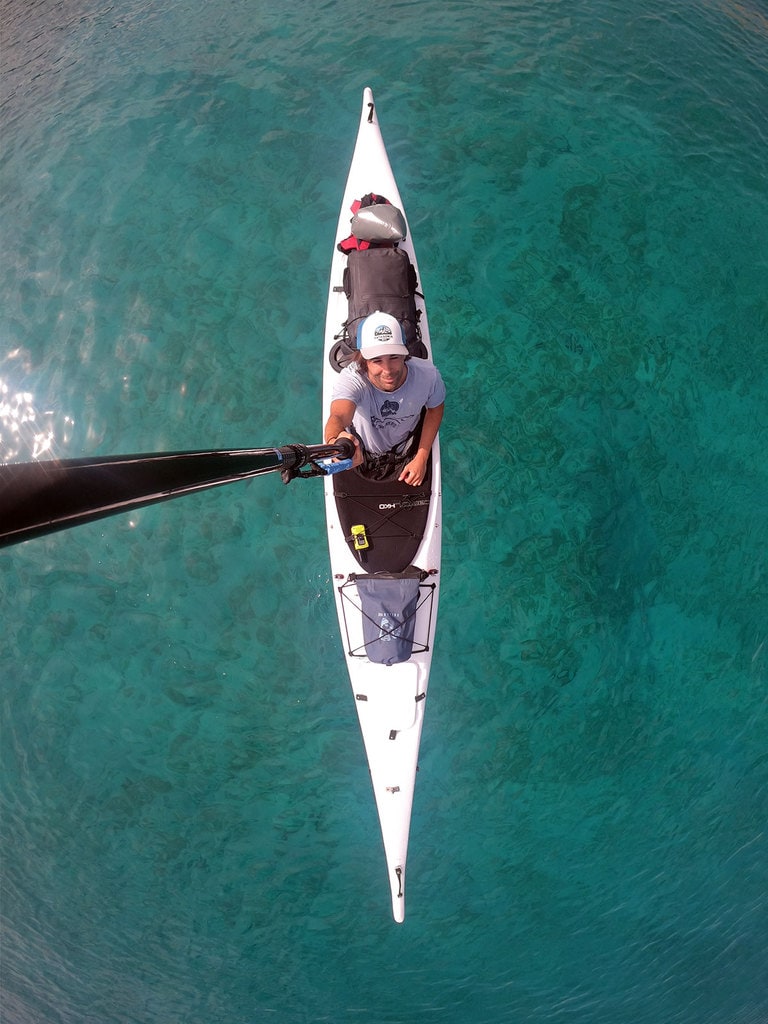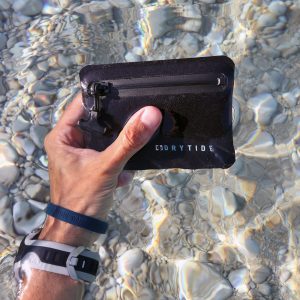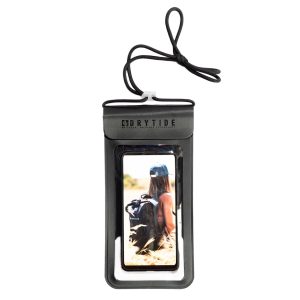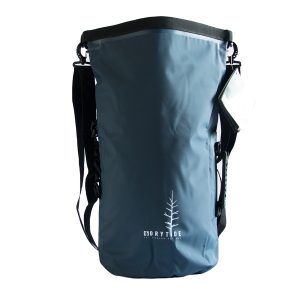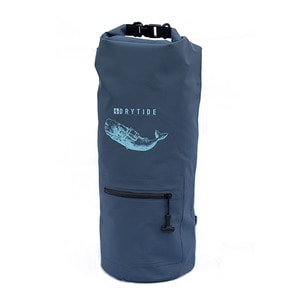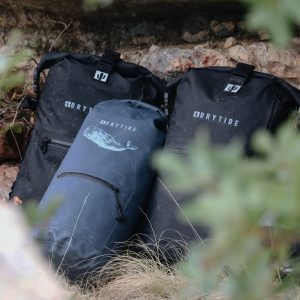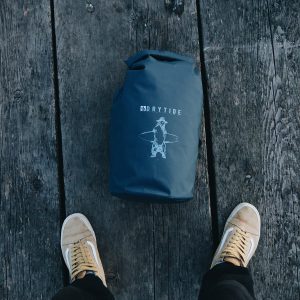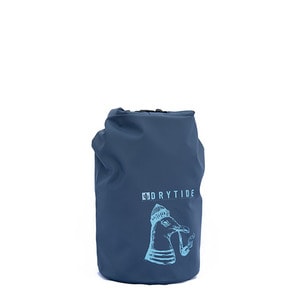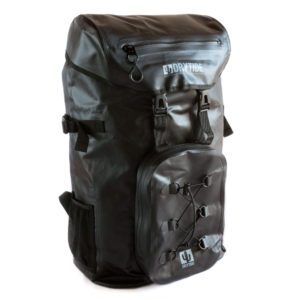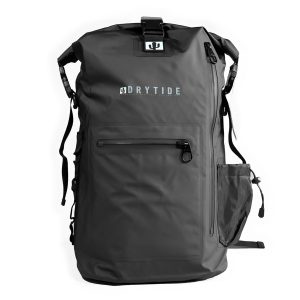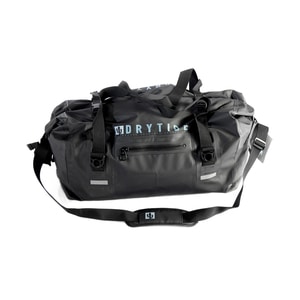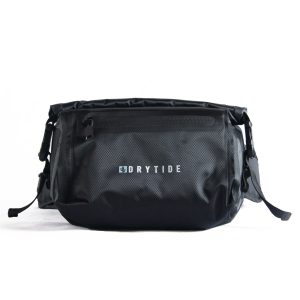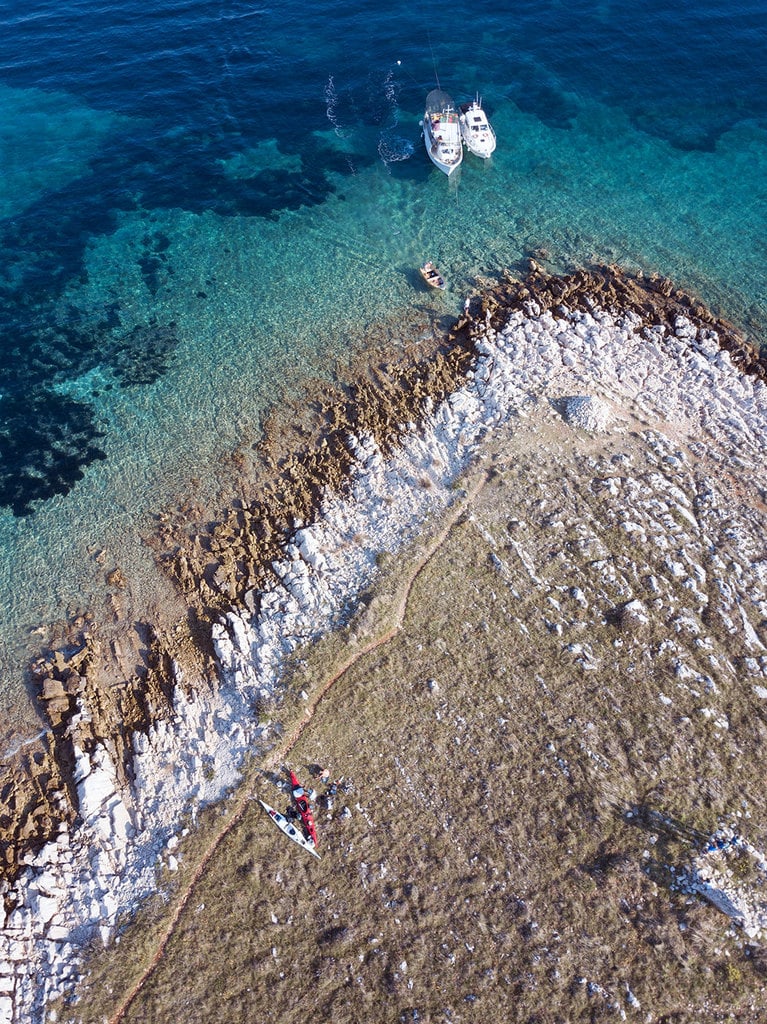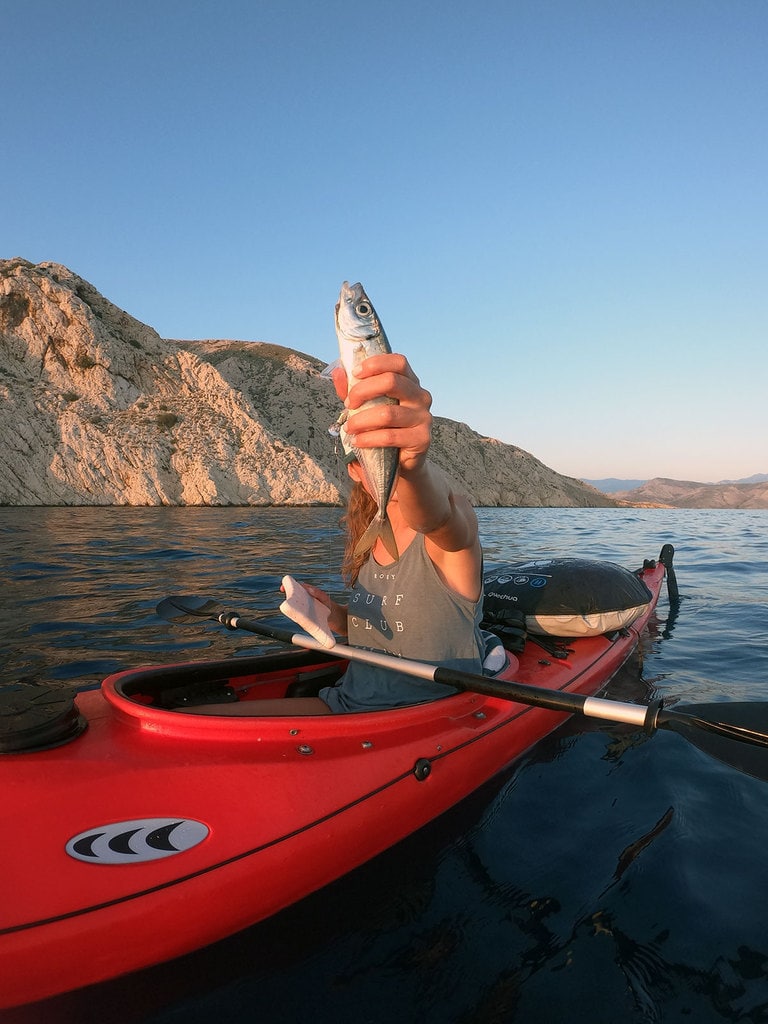Sea kayaking is all about the adventure and experiencing nature, especially the sea from as close as possible. It’s not an extreme sport for adrenaline junkies like for instance whitewater kayaking, although you can push any sport to the extreme. But don’t be fooled, doing multi day trips on your sea kayak away from civilization and relying only on the power of your arms to move around is not to be taken lightly! For a multi-day kayaking trip you will need the right equipment, have some experience and do some planning.
The purpose of this guide is to help you out if you are a sea kayaking beginner. If it’s your first time going out for this kind of adventure, you should consider a few things before launching off. In this article, we’ll go over the prep work required for a safe trip, all the equipment you’ll need for sea kayaking as well as everything that you need bring on a multi day sea kayaking camping journey. I will even throw in some sea kayak fishing tips.
What is Sea Kayaking?
Sea kayaking can be any paddling over the sea using a kayak. But usually when sea kayaking or kayak touring is mentioned, we are talking about a multi-day voyage over the sea (or big lakes, long rivers) where the primary mode of transportation is your kayak boat. While for a quick paddle on the sea any kayak will work, but for longer distances and for trips that last more than just a day a very specific type of kayak is used. You will find more info on sea kayak choice in one of the later chapters.
Sea Kayaking Video Guide
During one of our sea kayaking trip around Adriatic sea islands we have took lots off amazing shots. So we decided to make a part trip report part how to start sea kayaking guide video. Check it out at the top of this guide!
Sea kayaking is gaining in popularity these days. What is it, that draws people to it? The following is my subjective personal list of things I like about sea kayaking, it might help you find out if this is something that you would want to get into.
Sea Kayaking Pro’s
- Close contact with sea and nature, you are sitting right on the sea surface and you can reach places you could never reach without your kayak (like small coves, private hidden beaches, paddle right under magnificent cliffs) or see animals up close (jumping dolphins, tuna, seagulls fighting…)
- I love the sea, so being close to it makes me happy:).
- There is a special satisfaction when you move around using your own power without being limited by gas, wind… not to mention how quiet it is. And it’s a good exercise for arms, shoulders and core.
- Kayak is slow enough to really experience your surroundings. On the other hand it is still fast enough to cover vast distances and make a real trip and explore the coastline.
- Camping/sleeping on beautiful hidden lonely private beaches in the middle of the tourist season.
- Sea kayak is much less dependent on nice weather than for instance a stand up paddle board (we also did a guide on multi day SUP trips).
- You can catch your dinner (fish) while you are paddling.
Sea Kayaking Con’s
- You can not jump out of your sea kayak and into the sea to cool off (or at least it is very very hard to get back in). This means you have to find a beach, stop and then take a swim. This is true for the more popular closed cockpit sea kayaks. There are also open cockpit sea kayaks and sit on top kayaks where this is easily done. Sit on tops are however not suitable for serious sea kayaking.
- Watch out for the sun, you can get some serious sun burn if you paddle in summer.
- Although sea kayaks can handle wind, it is still way more fun and relaxing to paddle in calm conditions. So keep an eye on the conditions and don’t get caught on open sea when the weather gets bad.
- Sitting in your sea kayak is pretty comfy, but from time to time you will want to stretch which again requires you to find a beach and stop.
Basic Sea Kayaking Equipment
The basic sea kayaking equipment is simple. You need a boat and a paddle. Having the right sea kayak and paddle can make your trip a lot more enjoyable. After you cover the basics there are quite a few more equipment pieces that are highly recomended.
Sea Kayak
There’s no single kayak that will work perfectly in all conditions. Just by looking at different kayaks you will see huge differences in length and shape. Kayaks that are great for whitewater rafting are short and rounded. Kayaks that are used for touring and sea kayaking are much longer with pointier bow and stern. So how to choose the right sea kayak for you?
This is what you need to know about sea kayaks to help you out.
Sea Kayak Length and Shape
Sea kayaks are usually somewhere between 4.5 – 5.5 meters long (roughly 14-18ft), but can also be even longer, 6m (19ft) and more. They also have pointier bow and stern.
A longer kayak with a sharp bow and stern will be much faster and will cut through water better than a short round kayak. Longer kayak will also hold direction better which makes covering greater distances much easier. On other hand a longer kayak is harder to turn, but turning is not that important while touring.
Since sea kayaks are used for longer trips a longer kayak will also have special storage spaces where you can put your gear. Regular kayaks don’t have these or are really small. Sea touring kayaks are also designed with added gear weight in mind, so they handle great even when loaded. Among longer touring kayaks there are models that are more suitable for calm water and then there are those that can also handle some waves and rougher sea.
The length and size of the kayak is also connected to the size and weight of the paddler. Bigger heavier paddlers need bigger longer kayaks.
Material and Weight
Generally a lighter kayak is faster and easier to handle but more prone to damage and also more expensive. These are the materials usually used in sea kayaks:
Plastic (polyethylene)
There are a few different types of these kayaks ranging from heavy cheap beginner kayaks to some really good touring kayaks. But in general these kayaks will be heavier and a bit slower. At the same time these kayaks are almost indestructible so you don’t have to worry about rocks when you are dragging your kayak on the beach. They are the cheapest option, even the best ones.
Composite/Glass
These are stiff, lightweight and fast! There are different fabrics that can be used from fiberglass to Kevlar to graphite. All are lighter than plastic (polyethylene) kayaks, but even here graphite is the lightest. All are also more expensive than plastic (polyethylene) kayaks again graphite being the most expensive (really expensive!).
The downside of these kayaks is that they can be damaged on rocks, especially on impact. They are not that durable/indestructible as some polyethylene kayaks, but they can be pretty easily repaired.
Thermoform (ABS plastic)
These are somewhere in the middle. Made out of ABS plastic sheets, they are nearly as light as a composite kayaks and close to polyethylene kayaks when it comes to durability. Price is also closer to polyethylene kayaks than composite ones. Their downside is that this material deteriorates with time.
Storage Hatches
Storage hatches on sea kayaks have two tasks. The obvious one is that they carry all your gear when you are kayaking. The second one is flotation. These hatches are separated from the cockpit so even in case of cockpit filling with water the air trapped in these compartments will keep the sea kayak afloat. Of course this depends also on the hatch covers, how watertight they are and if the are closed correctly.
Rudder/Skeg
Sea kayaks can be used without a rudder or a skeg (I have a sea kayak without rudder/skeg) but it is just so much easier and more convenient to have one. The main purpose of rudders or skegs is not to turn a kayak left and right, but to keep a kayak running straight when you’re paddling with a crosswind. When the wind is not blowing directly head on or into your back the kayak will start to turn into the wind. This phenomena is called weathercocking. A rudder or skeg is used to fight this.
What is the difference between a rudder and a skeg? Both can be raised or lowered into the water when needed, but a rudder can also turn left and right using foot pedals inside your cockpit. This way you can use the rudder to also turn and point your kayak in the desired direction. This is especially useful when you are catching waves.
The Paddle
A general rule for paddles is the lighter the paddle, the easier the paddling. This is why carbon paddles are the best (and also the most expensive). As with composite kayak, carbon paddles can be damaged by a direct hit from a hard object (rocks etc…) so don’t throw your paddle to the ground. Fiberglass paddles are heavier but much cheaper and aluminum handle paddles are the heaviest and cheapest.
The length of the paddle can usually be adjusted, but this adjustment is a most 10cm (about 4″), so you will still have to get a right length paddle for you. The length of the paddle depends on your height (or shoulder width to be more exact) and on the width of the kayak. A wider kayak requires longer paddle. There is a great paddle length guide here.
The shape of the blades is also important. If we don’t go into the blade shape and hydrodynamics details there are two blade styles. Shorter wider blade for paddlers that raise their paddles higher when paddling and longer thinner blades for paddler that keep their paddles more parallel to the water when paddling.
Btw, it is more important to have a light paddle than it is to have a light kayak:).
Paddle Safety Leash
When you stop paddling to check your phone, navigation, drink, eat, rest… you put down your paddle on the top of the kayak. A wave or a clumsy move can knock the paddle off the kayak and into the sea. Instead of paddling with your hands from then on, get a safety leash for your paddle. It is an elastic string that attaches your paddle to your kayak so you can retrieve it if you drop it into the sea.
A Personal Flotation Device (PFD)
This piece of safety equipment is essential. Yeah, I know you know how to swim, but when things go wrong a life jacket can be a life saver!
A Spray Skirt

A spray skirt is the black neoprene cover that you see in the photo together with some simple fishing gear, a diving knife, paddle safety leash and a DryTide 5L dry bag in the front.
The last thing you want to worry about is your kayak taking in too much water. A spray skirt can prevent most of the water from coming into your cockpit either while you are paddling through rougher sea, when waves are splashing over and into your kayak or when you capsize. A spray skirt closes the cockpit leaving only a small hole your your body.
Manual Water Pump
If your kayak takes in water either from waves, rain or from capsizing a manual water pump will help you empty it. A small sponge will help you get rid of the last drops of water.
Waterproof Bags (Dry Bags)
You will be spending most of your time on and near water so there are plenty of opportunities for your things to get wet. You can either be clumsy and drop something into the sea, the splashing of the waves can bring water into the kayak, even into the storage compartments and finally, even things that do not come in contact with sea water will start to get humid if the are constantly close to the sea. This is why all kayakers use dry bags.
More or less everything you have with you on a sea kayaking trip will be safer inside a dry bag, but this especially goes for:
- all your electronics,
- everything you want to have close at hand on the top of the kayak,
- things that should stay away from moisture like a down jacket or sleeping bag,
- your dry clothes,
- food that can not get wet like salt, flour, pasta etc… (these can also be put in plastic containers),
- everything that doesn’t fit inside your storage hatches and is attached to the top of the kayak.
Dry bags are usually used for this although a waterproof backpack can be even more useful if you will also stop and walk around. Sea kayaking dry bags should be sized between 5 and 30L (check out our 5l Seagull, 15L Bear and 30L Whale dry bags), you will have trouble getting bigger ones inside your kayak. Using smaller bags space can also be used more efficiently. Bigger bags can be put on top of the kayak (like our 50l duffel bag or our 50l waterproof backpack).
Check out our Ultimate Guide to Buying Dry Bags for more info on dry bags.
If you will stop and walk around a waterproof backpack is a better option than a dry bag because it is much more comfortable to carry. Depending on how much gear you want to take and how long trip you want to make away from your sea kayak you can go with a larger or smaller backpacks. Keep in mind that a big backpack, like the 50L, will not fit inside your kayak. You can however always strap it to the top of the kayak.
Equipment listed up until now falls into the must have category. What follows are the nice to haves that come in handy in some situations but are not necessary for everyday sea kayaking.
Tow Systems
When Kayaking with other people, you might have to tow each other in some situations. Maybe someone is really tired or has problems with his paddle and does not have a spare. In this case a tow line can help. You could use any rope for this, but a special tow line is easier to use and faster to set up. A standard tow system used by touring paddlers has a tow belt for the person doing the pulling and a line that ties to the other boat and clips onto the tow belt.
Lights
You don’t want to be out in the water after dark without lights. You shouldn’t be on the water after dark at all if you can help it. But if you do find yourself in that kind of situation, make sure that you use a light to indicate that you are there. A waterproof headlamp and bright LED lights that mount to the deck are usually used. Reflective tape is another visible option you’ll want to consider so that other boats can see you better at night.
Sea Kayaking Trip Packing List
Above we have covered all the equipment pieces needed for sea kayaking. But there are many other things that you will need to take with you if you will go on a multi day sea kayaking trip.
This list is a general guide to get you started on the right path. There is no such thing as a perfect list of gear. It depends on your location, season, weather conditions, personal preferences etc… When in doubt, err on the side of safety and caution. That way, if anything does go wrong during your trip, you’ll be prepared.
Clothing
When deciding on what clothes to bring, you’ll want to make sure you pack light and dress for the weather. There’s no one clothes packing list for all your trips. This list will vary on each tour. A few useful tips here:
- Even in summer, bring something warm (light down jacket and a beanie) and something that is wind resistant (windbreaker jacket) so you will be able to stay warm if the weather changes.
- In hot summer days don’t forget your sun protection: sunscreen, a hat, sunglasses, long sleeve lycra top, paddling gloves etc… especially if you have a fair skin. A hat will also put your eyes into a shade and reduce the glaring from the water surface so it’s useful in any season.
- In colder seasons stay away from cotton because it is not very warm when wet (sweat and water).
- When weather is colder you can use a special kayaking jacket to keep warm and dry, you can also use a neoprene top that keeps your warm even when it is wet. In extreme cold a wet suit or even a dry suit is used.
- Always have something dry to change into when you stop paddling (use dry bags to keep all your clothes dry).
- You will usually paddle in the same salty sweaty t-shirt every day, you don’t need that many clothes to change (less is more). Also a kayaking trip is an escape from the civilization, so you are obliged to look a bit like a castaway.
- Depending on where you land and what the water temperature is you might need neoprene booties for walking on sharp rocks and for cold water.
Food and Water
The amount of food you bring with you will depend on how long your trip is and how many people are going. It’s a good idea to bring a little more food than you think you’ll need. That way, if you’re out longer than planned or need to share your snacks with someone, you’ll have enough. What kind of food should you bring? This depends on personal preference, your “in the wild” cooking abilities and the amount of storage space you have available inside your kayak. Some foods take up more space than others.
Here are a few tips on what food to bring:
- Basic sea kayaking food is canned food and pasta + sauce, both are really easy and fast to prepare, don’t need much pots and pans which means less cleaning and pasta is a well know energy source. Both also don’t take up much space.
- Dry soup mixes are also great, a warm soup tastes especially good when the evenings get warmer.
- Keep in mind that you won’t have a refrigerator on your trip. So foods that belong into the fridge (fresh meat…) are out of the question (or you must use them right away, first or second day).
- Keep the things that you want to keep cooler at the bottom of your sea kayak. This way they will be closer to water which is usually cooler than air (especially in summer). This way they will not get as hot as you would think they would in a small closed compartment in the sun.
- You should also bring high energy snacks like trail mix and store them where you can easily reach them for a quick bite during paddling. You are going to burn through a lot of calories by paddling all day.
- Bring some tea or coffee and milk for that civilization feeling in the morning.
- Cereals mixed with nuts and dried fruit are good for breakfast.
- Eggs will give you even more energy if you have them for breakfast. You will then also need some bread.
- Bring some fruits and vegetables if you have room. Hard fruits like apples last longer, lemons make a refreshing lemonade.
- Bring some hydration tablets.
- Bring your fishing gear, there are some sea kayak fishing tips further down this guide.
You will also need to bring water. Keep in mind that you will not only need the water for drinking but also for cooking, maybe also for brushing your teeth and things like that. How much water do you need on a sea kayaking trip? It depends on the weather and temperatures. In summer I can generally get away with around 2-3L (half a gallon to 3/4 gallon) of water per day for everything (I also bring also some milk and beer), but I am a bit of a desert person and I don’t need that much water for some reason:). So to be safe bring about a gallon per person per day.
First Aid Kit
A first aid kit is always recommended in all the trips you plan. A proper kit should have, at a minimum:
- adhesive bandages
- gauze and tape
- nonprescription pain relievers
- Moleskin
- disinfection solution
- Any personal prescription medications
Hypothermia is easily the most common health issue you might come across so as said in the clothes chapter, bring something warm to wear.
Repair Kit
A repair kit can really come in handy if you require one. If you’re in a group, having multiple kits can be a good idea, depending on how long your tour is. A standard repair kit should include:
- Electric tape
- waterproof duck tape
- Epoxy putty
- A flotation bag to keep the boat floating when the compartments become compromised
- tools and parts to fix a skeg or rudder
A pump tool and a sponge will come in handy for when too much water gets in your cockpit, and you need a way to get it out.
Even in today’s age a compass and a paper chart inside a vinyl pocket are a really good idea to have on your trip. Knowing how to use them of course. Usually you will have a GPS device that can be your phone and use it for navigation. But it is not as fail safe as compass and paper chart. You can run out of batteries or your GPS stops working for whatever reason.
So this is what you should bring:
- Your cell phone with navigation
- Handheld transceiver, if there are more people in the group and you want to easily communicate
- Emergency Whistle
- Flares
- Smoke signaling mirrors
- Sea dye
- Strobes
- Reflective tape
These items depend on the scale of your voyage and how far into the wilderness are you going.
Power Banks and Solar Panels
Calculate how much juice you need per day to charge your phone, cameras, speakers etc… and then bring enough power banks to charge all these. If you are making a trip that will last more than 2-3 days it is very useful to also have portable solar panels. This way you can charge your power banks while you are paddling in the sun. Always charge your power banks and not directly your phones etc… because the current from portable solar panels is very “uneven” and it is better to ruin a power bank than your phone batteries.
The Ultimate List
Now lets put everything together also adding all the things I did not mention so far. So here it goes, the ultimate sea kayaking packing list:
- Sea kayak
- Paddle and spare paddle
- Paddle safety leash
- Spray skirt
- Life jacket
- Dry bags
- Water pump and a sponge
- Rope (or tow system, rope is always useful)
- Kayak repair kit
- Navigation and communication equipment (your phone, map, compass etc…)
- Headlamp and additional lights if you plan to paddle late in the evening and at night
- Clothes
- Food and water
- First Aid kit
- Sunscreen
- Power banks and solar panels
- Foldable water containers for the water that you will store inside your kayak hatches
- A water bottle that will be with you for drinking while paddling
- A small empty plastic water bottle that will be with you if you really have to pee while paddling (it is really hard to get back in to the kayak from the sea without filling the kayak with water)
- A knife
- A small tent
- Sleeping pad
- Sleeping bag (always store it in a dry bag)
- Inflatable pillow
- Insect repellent
- Insect repellent candles for evening romance
- Personal hygiene items, wet wipes are also very useful
- A small propane stove with extra propane bottles
- a lighter (very important!) and some fire starter material if you will want to start a bonfire
- A small pan for making eggs and steaks
- A small pot that fits pasta for two people
- Coffee mugs
- Light 3 piece cutlery set for traveling (spoon, fork, knife)
- Spices, oil, vinegar
- A tarp or a cotton sheet for shade during summer beach stops. Tie a piece of rope on each of the corners so it can be attached to rocks, trees etc…
- Cameras (DSLR, GoPro, drone etc…, store them in dry bags)
- Bluetooth speaker if you want to listen to music while paddling
- your fishing kit and a bag for the fish you catch
- a hammock
Preparation: Before You Head Out
Map Your Trip
Before you even get out on the water, you’ll need to have the entire trip mapped out. The launch point, the location of suitable beaches where you can stop to rest or to sleep, and what is your final destination. I usually use satellite view on Google maps to do this and it works pretty good. Measure the distance of the whole trip and then divide it by the number of days that you have available. This way you can see if the trip is doable and how much do you have to paddle every day. Always leave some margin for bad weather conditions. Plan your trip a bit shorter than what you are normally able to paddle.
When you know how much you have to paddle each day you can try to find suitable landing spots at that distance and mark them on the map. Also look for alternatives if the first choice turns out not to be that good.
When you have the trip mapped out you will also see how much gear, food and water you will need.
How Much Can a Person Paddle Per Day?
This depends on your stamina, the weather conditions and what you want from your trip. If you want to paddle the whole days you can obviously paddle a greater distance than if you want to stop, swim, snorkel, fish, rest etc…
I would say that almost anyone can paddle around 15km (about 10 miles) per day. An occasional paddler that also wants to enjoy the beaches and not only paddle can cover 15-25km per day (10-15miles). An occasional paddler that only paddles can cover 25-40km per day (15-25miles). Although after a few consecutive days of paddling this will take its toll on the body and you will be tired. A trained sea kayaker can paddle even more, 40-60km per day (25-37miles).
Also keep in mind that during your first paddles you might get blisters on your hands. So maybe it is best not to start your sea kayaking career with a really long trip. If this is your first time on a multi-day kayaking trip, consider going on a guided tour. It’s the safest option and will most likely provide quality equipment you might not have as a beginner.
Check The Weather!
You always, ALWAYS have to check the weather forecast before the trip and also every day during the trip. More on weather in the next chapter.
Safety Precautions
Weather
Safety first! Sea kayaking as an activity is super safe. The catch is, that it happens in nature. As long as the water is calm and the is weather is nice, there is not much that can happen.
But! Things can change pretty fast and weather changes on open sea have much more severe consequences than weather changes on dry land. An once pond like sea surface can become a scary monster in a matter of minutes. Strong winds, big waves… being caught out on the sea in these conditions can have serious consequences. Kayak tipping over and filling with water in the middle of bad weather can mean a disaster, you can also get blown out of direction and lost, suffer hypothermia etc…
This is why you always need to keep a close look on the weather forecast and predict in advance what will happen and then plan your trip accordingly. Maybe you will even have to postpone or cancel it. You will have to be become really good at reading different weather forecasts. You will also need to gain experience that will help you translate the forecast into actual sea conditions. For instance, how 10 know wind feels like when paddling etc…
Weather forecasts will also not predict local weather changes that are influenced by the topography, there can also be strong currents out on the sea etc…
If you get caught in a thunder storm you will face another danger. Lightning hits the highest objects around and if you are in the middle of the sea that will probably be you. Use low angle stroke, put your head down and remove anything that has metal.
Sea Traffic
Pay attention to the boat traffic in the area that your kayaking. Larger boats might not see smaller kayaks that are right in front of them. If padding in poor visibility or at night use lights to indicate you are there.
Spare Paddle
A paddle is the one thing that if you loose it or break it there is not much that you can do, you are stuck. This is why most paddlers carry a spare backup paddle.
Let Someone Know Where You Are
You will also want to make sure that there is someone back home that also knows your travel plans. They should know where you’re going, who’s with you, and when you’re planning on returning.
Sea Kayak Paddling Technique
Make sure you’ve practiced your paddling before going on a longer trip. Having a good paddling technique makes it less tiring to paddle and lets you control your kayak more easily. You should also get familiar with your kayak and build up some paddling endurance if you are planing a longer trip.
In general paddling is not that hard to master, you can pick it up quite fast. A few starting tips would be:
- paddle evenly, making same length and same power strokes at the same distance from the kayak on both sides of the kayak,
- try to paddle with your core, not with your arms, arms are there just to hold the paddle. This way your arms won’t get tired as quickly.
Paddling in Wind Without a Rudder or a Skeg
If you don’t have a rudder or a skeg on your sea kayak then any side wind will start to turn your kayak from the desired direction. This is called weathercocking. You can to some degree compensate weathercocking with your paddling technique. How?
Instead of holding your paddle in the center move your hands to one side so that the blade on one side of the kayak goes into the water further away from the kayak than on the other side.
You can also paddle normally for a while and then steer the kayak back into correct direction by putting the paddle blade into the water on one side of the kayak.
You can also include a wide sweeping stroke on one side of the kayak every few turns.
All this can help to some degree but reality is that with side wind you will be doing a lot of paddling on one side of the kayak. This means one arm will get more tired that the other and can also lead to some cursing etc :).
Self Rescue
Another smart thing to do is to practice self-rescue. If your sea kayak capsizes, you will have to know what to do. The safest and fastest recovery technique (but also most difficult to learn) is an eskimo roll. Using an eskimo roll you turn your kayak around without going out of it using just you body and your paddle. This way minimal amount of water gets into the kayak as the spray skirt stays on and prevents the water from getting in.
Practice your eskimo roll in calm water close to the beach. There is a good guide on how to do that here. If you don’t know how to do an eskimo roll you will have to get out of the kayak, turn it around, climb back in and get rid of all the water that got in (a manual water pump can save you). All this is not easy to do, especially in bad weather so also try this first in calm conditions near a beach.
Sea Kayak Fishing Tips
In this last chapter I will go over some fishing tips. Sea kayak fishing tips are hard to find. That is, if you are not looking for tips on how to do kayak fishing. What is the difference?
Kayak fishing is when people use kayaks to go fishing. There are even special fishing kayaks available, people use fishing rods and bring all sorts of fishing gear with them. The point of their whole kayak trip is to fish. Obviously their success rate is higher and you will also find lots of tips on how to do kayak fishing.
But this is not something that a sea kayaker on a multi day paddling trip wants to be doing. A sea kayaker wants to fish while he is paddling towards his destination for the day. We want to be moving, not sitting around in one spot and fishing. This is why this type of fishing is quite different or at least specific. And there are not many tips on how to do it.
So here I will give you a few tips on how to get started.
Fishing Gear
The only way to fish while paddling is by using a technique called trolling. Trolling is a method of fishing where draw a fishing line with lures or bait fish tied at the end through the water behind your kayak. This means that you have to be moving to fish.
To do this you won’t need much equipment, everything is really simple. Now real fishermen will use fishing rods for trolling. But for fishing during our kayaking trip you will need:
- Fishing line winding board, this is where you wind your fishing line on when you are not using it. It can be made out of foam, Styrofoam, even wood. It’s good if it floats if you drop it into the sea. This is dirt cheap.
- Fishing line. You will need two fishing lines of different thickness. A thicker one that should be 20-25m long (66-82ft) and a thinner shorter one that should be about 5m long (16ft). Fishing line thickness depends on the fish size that you want to catch and the bait size that your are using. But with this simple method and without a fishing rod I suggest you go for smaller fish. So thicker line should be somewhere in the .3-.4 range and thinner one in .25-.30 range.
- A swivel (not mandatory, but it helps)
- Artificial baits (fishing lures) of different shapes and colors. For smaller fish I usually stay under 10cm (4inch) length when it comes to these.
How To Set It Up?
Winding board -> thicker fishing line -> swivel -> thinner fishing line -> fishing lure.
If you are wondering which lures to get, get minnow and wobbler lures. There is a whole science with these, they can be sinking, floating, different sizes, different colors etc… Just get a few different ones and see which work best.
How To Fish From a Sea Kayak While Paddling
Slowly unwind the fishing line behind your kayak, make sure that the hooks on the lure don’t get tangled into the line when you put the lure into the sea and unwind first few meters of the fishing line. When you unwind the whole line, strap the winding board onto your kayak, it’s best to tie it to some bungee cords if you have them on top of your kayak.
This way when the fish bites the line will give in a little and it won’t pull on the fish too hard. This way there is less chance of fish unhooking.
Perfect paddling speed for this type of trolling is somewhere between 2-4km/h (1-2knots). You will see that usually you will paddle a bit faster, I caught the most fish when I was paddling really slowly.
Fish bite best in the morning and in the evening. If it’s sunny use a lure that is fish colored (silver), if it is cloudy use a lure that is bright and more visible (yellow, orange etc…).
There are different setups for different types of fish, but while you are on a sea kayaking trip you just want something simple. That is pretty much it. You will also need some luck and a delicious campfire dinner after a day of paddling will be yours.
This ends our sea kayaking guide, share it if you find it useful, comment if you have some additional tips that you want to share.



